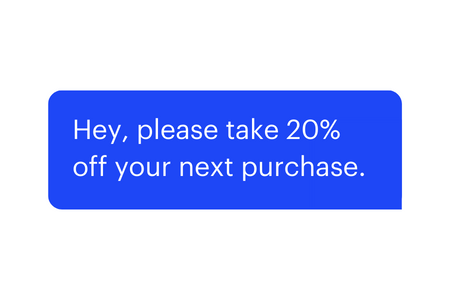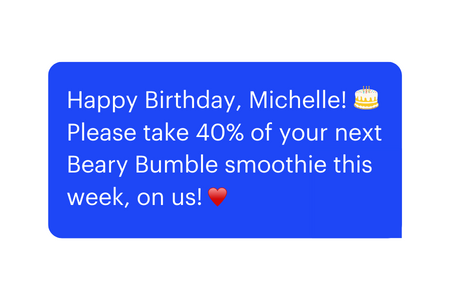What is Direct Marketing and Why Should Small Businesses Try It?
“Hey there! Happy St. Patrick’s Day. Take 10% off your next bouncy slide purchase.”
Would you respond to this text? Neither would we. It’s not personal, it’s not relevant, and it’s targeted at the masses.
In the age of personalized marketing, one size no longer fits all. Small businesses need to actively contact their customers with marketing that is tailored uniquely to them. But they need to use methods that won’t increase workload or stress. That’s why many businesses are turning to direct marketing: the marketing strategy that’s taking industries by storm.
Read on to learn what direct marketing is and how to make it work for your business.
Defining Direct Marketing
Many marketing strategies are directed at the mass market. Consequently, no matter how well done they are, they can miss consumers’ individual needs and key factors that might tip them into purchasing from you. Direct marketing is a promotional strategy that enables you to communicate with individuals directly. In contrast to indirect marketing, it skips the middleman. You’re able to engage directly with your target audience without any interference.
Why is direct marketing so popular? It’s able to get a strong response from customers because it is direct–and because it’s personal. According to Forbes, 66% of customers expect businesses to understand their unique needs and expectations. Over half expect all marketing offers to be personalized specifically to them. Direct marketing uses technology to meet these expectations consistently. It’s the difference between:

And

There are many effective ways to market directly, such as email marketing, SMS marketing, and direct mail campaigns. Understanding your business and its particular strengths and weaknesses is crucial to making direct marketing work for you.
Understanding the Types of Direct Marketing
As we mentioned, there are various direct marketing strategies:
- Email marketing
- Direct mail
- Telemarketing
- SMS marketing
- Kiosk marketing
- Social media marketing
- Internet marketing
- Content marketing
- Directed ads
- Experiential marketing
- Catalog marketing
- Chatbot marketing
The list goes on and on—digital marketing, direct selling, direct contact with existing and potential customers. The secret is knowing which ones will be most effective in reaching your customers and promoting your specific business (hint: consider where your customers spend most of their time). Let’s touch on a few of the heavy hitters.
- SMS marketing allows you to meet customers where they are: their phones. Text’s response rate is 209% higher than phone, email, or even Facebook. And over 40% of customers say they’re likely to switch to a different business because they use text to communicate. And with the help of automation tools, SMS marketing can be your new go-to. Check out our SMS Marketing Guide to get the full scoop.
- Chatbot marketing uses chat features on your website or app to engage customers directly. This can include answering questions and sending personalized recommendations or offers, and these chat features can be automated, staffed by employees, or both. Through chat features like Webchat, businesses have seen a significant increase in revenue and up to 5x their usual website interactions.
- Social media marketing is also a particularly effective (and cheap!) strategy for businesses, large and small. It is quickly becoming a mainstay for consumers to have conversational engagement with brands. You can message directly, offer product demos, and provide consultations over many social media platforms, including Instagram, Twitter, Messenger, and more. Make sure to respond to all of the comments you get on your posts. When someone engages with your social posts, it shows that they’re already interested in what your brand has to offer and could be likely to make a purchase.
Pigeonholing yourself to one channel can limit your reach and the demographic to which you appeal. The most effective small businesses use several different channels at once—they take an omnichannel approach. The idea is that you want to show up on as many of the channels that your target audience uses as possible in a personalized way.

Building a Direct Marketing Campaign
So, how do you get started? Let’s break it down.
- Identify your target audience. The best way to make sure your direct marketing doesn’t feel pushy or aggressive is to ensure it’s well-targeted. Your message should speak directly to a micro-demographic—a super-specific segment of your audience that takes into account critical factors that influence their decisions: their history with your brand, average purchase spend, geography, level of engagement, age, gender, etc.
- Create an offer. How do you make an offer they can’t refuse? Make it relative. And make it valuable. An offer is not an invitation to “contact us” or read a fact sheet or press release. An offer includes ebooks and guides, discounts and promotions, case studies and research, loyalty programs, templates, tools, webinars, free consultations, and discounts—things that will add value for your customer.
- Craft effective messaging. Effective messaging centers around personalization. Always address customers by name and make sure they know why you’re sending the message—whether it’s a holiday, a birthday, or snow tire season is coming up and you know that they might need new tires. Your customers should feel like you get them—like you’re anticipating their needs before they are.
- Send at the right time. Technology is a critical part of this. As you know, it’s important to hit customers with the right promotional messages at the right touch points. When are they most likely to make a purchase? Plus, timing plays an integral part in something feeling personalized.
Measuring Direct Marketing Success
As always, tracking and measuring the success of a direct marketing campaign is vital to setting your business up for long-term success. This starts with measuring key performance indicators (KPIs) such as response rate, conversion rate, ROI, and more. Let’s go over a few of the most important marketing metrics every small business should track.
Your response rate is the number of people who respond to your direct marketing campaign. You can find this value by dividing the number of people who responded by the number of people who received your direct marketing communication, and multiplying it by 100 to get a percentage (700 responses/ 10,000 messages X 100 = 7%).
Your ROI is your profit divided by your investment.
To calculate conversion rate, you simply divide your total number of conversions by the number of campaign interactions that can be tracked to a conversion in that time period.
Other important KPIs include gross and net revenue, lifetime value, and cost to acquire.
Ensuring your strategy is measurable helps you understand when your customers aren’t connecting with your marketing efforts and what you might be missing. Even if you’re mid-execution, you can pivot to adjust for needs and expectations. Afterward, well-recorded data can help you and your team understand what happened and what you can do to make things flow more smoothly in the future.
Successful Direct Marketing
Successful direct marketing doesn’t have to be a hassle for you or add more stress for your team. When done correctly, a direct marketing campaign involves planning ahead and executing with tools that make your job easier—automated tools that send the right message at the right time and route responses effectively.
If you understand the types of direct marketing and the advantages of each, your customers and what they’re looking for, and how to measure, you’ll be well on your way to making direct marketing campaigns that directly impact your bottom line.
Podium helps small businesses like yours automate their marketing efforts, streamline customer communication, and get more done in less time. Interested in giving it a try? Start a free trial today.
Get started today
Ready to grow? Scale your business with an AI-powered lead conversion platform.







